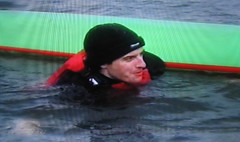
Can I canoe? Can I bobbins.
It’s possible that this sport may define the phrase the TV commentators love to bandy about - “It’s not as easy as these athletes make it look.”
That said, it might not be quite as difficult as I was making it look.
Saturday morning was all about the flatwater. Shaun Cavern, expert canoeing coach, met Tim (expert cameraman) and me (distinctly inexpert canoeing wannabe) at the finish line of the 2000 metre lake.
I’d been warned that the length of the lake would surprise me, but it still surprised me. As our host put it: “Sitting at the far end pointed this way, it feels like you can see the curve of the earth.”
When we arrived, Shaun was talking to some lunatic who had clearly forgotten his kayak and had come out for a paddle around in a hollowed out pencil. As we approached, the lunatic paddled off at a remarkable speed for a man kneeling on one knee in half an HB.
Introductions completed, I asked Shaun what the lunatic was playing at. “That was a C1 – I imagine you’ll have to do that one too at some point, won’t you? Probably not today though.” Probably not, no.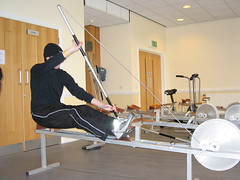
It's a bit like trying to swing two golf clubs at the same time.
It all started promisingly. Shaun took us inside to a very ingenious canoeing machine to run me through some basic techniques. I paid very close attention and tried as hard as I could to do what he was telling me – cock the wrist this way, point the elbow that way, reach to the front of the stroke with a straight arm. It seems funny now – by the time I got into the boat, it became fairly clear that I wasn’t going to be reaching for much other than a towel and a change of clothes before too long.
A ‘sprint’ kayak is designed to do just that - sprint - to go as fast as possible in a straight line. Unlike the kayak I paddled around Plettenberg Bay a month ago, which remained pretty stable despite a fifteen-foot Indian Ocean swell, the kayak Shaun put me in felt like it was going to struggle with the fifteen millimetre ripple being thrown up by the cold Nottingham wind.
Having suggested I might be better to take my shoes off in case they got wet, Shaun took great care in telling me how to get into the boat. I followed his instructions to the letter and got in without a problem. Once there, I listened just as carefully to him telling me how to get out again, but I knew I wouldn’t need that information. My only question about the whole process maybe gave away just how confident I was feeling, “Is the water deep?” His answer wasn’t quite what I was looking for… “It’s deep enough.”
Deep enough for what? To drown? To avoid hitting my head on the bottom if I went belly up? To contain flesh-eating animals?
I set off bearing the grimace of a man in trouble. The slightest shift in weight makes the boat wobble. “Just let it wobble. Never let go of your paddle,” Shaun shouted from the bank (not that I’d progressed far enough out for him to need to shout) “Don’t fight it or you’ll get wet.”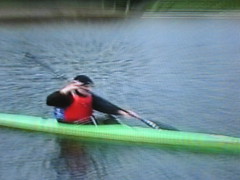
Cock the wrist this way, point the elbow that way, reach to the front of the stroke with a straight arm.
I was already getting wet. The shape of the racing blade may be scientifically precise in terms of gaining that vital extra second, but it is also quite conducive to scooping water all over your lap when you’re paddling at 0.62 mph.
Somehow I made it 40 metres to another jetty where I was met by the increasingly amused Shaun and the constantly amusing Tim. “That wasn’t too bad – you made it further than I thought you would.” Shaun confided gently, encouraging me. “1000 metres is going to take you about a week at that speed, mate.” Tim quipped from behind the camera.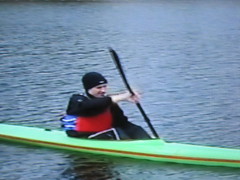
I turned the boat around and headed back in the direction from which I had come. I was starting to get the hang of it a little. It felt like it was wobbling less. Tim later likened it to trying to ride a bicycle very slowly – it’s actually easier to keep it balanced if you’re going a bit faster. Perhaps I was thinking the same thing when I decided to dig my next stroke in a bit deeper and build up some speed.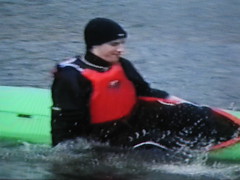
You don't get great whites in Nottingham, do you?
I cocked my wrist this way, I pointed my elbow that way, I reached to the front of the stroke with a straight arm, and then I fell in. The boat wobbled and I fought it (mistake number one), and then I let go of the paddle (mistake number two) in order to cling to the side of the boat (mistake number three), and that was all she wrote. I’d call it a capsize, but it wasn’t even worthy of the name. It was like a rat deserting a sinking ship.
Like a lady swimming with a new perm - my hat stayed almost dry.
Shaun was right - it was indeed "deep enough"
The water was incredibly cold and by the time I’d swum the twenty metres back to the jetty I couldn’t feel my fingers or toes anymore. Shaun looked me up and down and asked me if I wanted to have another go or to go and have a shower. It was all I could do to stop my teeth chattering long enough to take the second option.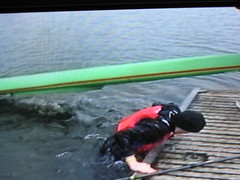
All ashore that's going ashore!
Tim reassured me the whole way to the changing rooms that really it was a great success – he’d got the whole thing on film and my shoes were still dry. All I could think was that the next day I was going to have to do it again, only then I was going to have to do it through a raging torrent rather than on a millpond.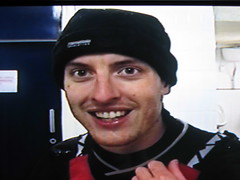
Despite the cold and the humiliation, I still found it quite amusing.
* * *
I'll save the write up of Sunday's exploits for tomorrow night - I'm still exhausted from the weekend, so if I'm going to get back to my triathlon training in the morning, I'm going to need to go to bed about half an hour ago.
Making a Splash
Monday, April 18, 2005
Posted by John McClure at 9:38 pm
Subscribe to:
Post Comments (Atom)
2 comments:
I did say that a mask and snorkel may be required. You could have then continued to paddle while capsized you see...
Still, big round of applause for both the Ultimate Olympian and his erstwhile cameraman - the facial expression of olympian in water is most priceless!
Sir, if you managed to make it 40m without capsizing on your first attempt, I would say that you are a genuine genius of the flatwater kayak. Most adults cannot make it 4 metres.
What you should have done, of course, was have yer man take you out in the K-4 first, so that you could have three experts holding you up. But probably he did not want to risk it in the cold.
I have put a link to The Ultimate Olympian on my blog, Now THAT's Amateur.
Post a Comment